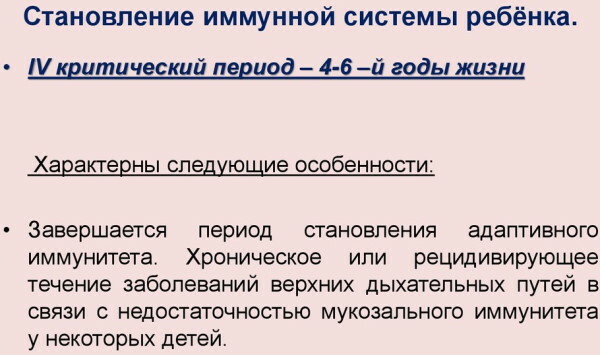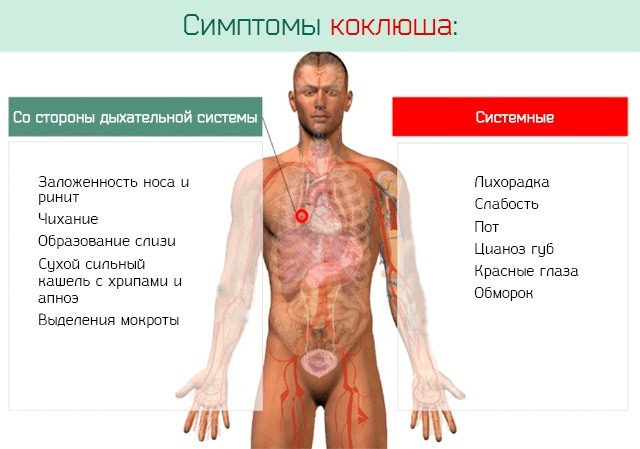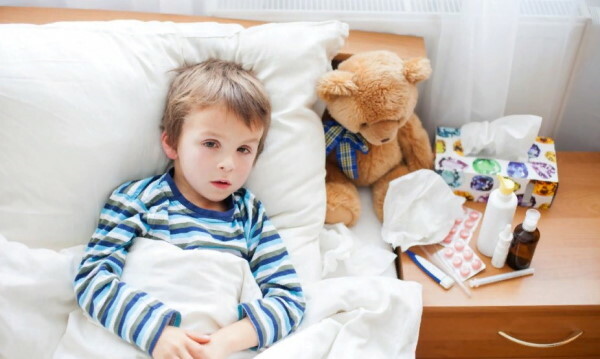Content
- Features of the immunity of children 3-6 years old
- What is the reason for the recurrence of episodes of acute respiratory infections every 2-3 weeks in children attending kindergarten
- Do I need to panic with frequent colds in a child or is this the norm?
- Why are frequent episodes of acute respiratory infections dangerous?
- What examinations need to be done in order to exclude dangerous diseases
- Could a chronic infection be the cause of frequent acute respiratory infections?
- What are the best means to treat acute respiratory infections, admission regimens
- Traditional methods of treatment
- Actions after recovery
- The main mistakes of parents
- Video about the causes of frequent illness in children
Human immunity is a complex system, which is endowed with the body to fight pathogens. Medicine distinguishes between nonspecific immunity, also called innate, and specific - acquired. A baby is born with its own immune system, which is reinforced by maternal antibodies. They play the role of acquired immunity during the first 6 months of life and protect the body from infectious diseases, preventing them from getting sick every 2 weeks.
Features of the immunity of children 3-6 years old
From the age of 3, children attend preschool institutions, and some even earlier. At this age, the real tests for the immune system begin. This is due to the fact that before the child begins to go to public places, he contacts only with family members. And if one of the relatives gets sick, the carrier is immediately isolated from the child, protecting him from infections.
As soon as the visit to kindergarten begins, the body is closed for several hours indoors. with other children, each of whom carries their flora to the group from home, and often she finds herself pathogenic. In kindergarten, children interact closely, playing with shared toys and tasting them. It is very easy for viruses and bacteria to get from the surface of the mucous membrane of one child to another.
To resist a new infection, the immune system must form a response, create antibodies that are not will allow the next time the same type of virus to cause a disease or significantly reduce the severity symptoms. Therefore, at the age of 3 to 6 years, the immunity of children is prepared for life in society and is strengthened through the formation of responses.


Children who have not attended a kindergarten or private preschool circles at this age get sick much less often than their peers, but their immunity remains unprepared for life in society. Once in school, the child will begin to get sick as often as preschoolers do, which will certainly affect academic performance.
What is the reason for the recurrence of episodes of acute respiratory infections every 2-3 weeks in children attending kindergarten
The child gets sick every 2 weeks, because that is how long it takes for the immune cells to form a defense against the pathogen. But viruses are innumerable in nature, and most of them cause similar symptoms in the form of a runny nose and cough. Therefore, having been ill once, the preschooler again returns home with a temperature after several days in the team.
On average, the acute period of viral respiratory infections lasts 3-4 days. On the 4th day, the temperature begins to decrease, and by the 7th day, a stable immune response is formed. The field of the weekly hospital pediatrician gives a certificate of the child's health and allows him to return to the team. Returning to the group, the child's immunity again encounters the virus of one of the pupils. The incubation period is on average 7-14 days.
In other words, it can take up to two weeks from the moment of infection until the first symptoms appear. If this is a new virus, with which the immune system has not yet had the experience of fighting, the disease will develop rapidly and in full. It will take another week for the antibodies to form.
Immunity to viral respiratory infections is short-lived. On average, it protects no longer than six months. Therefore, episodes of illness are repeated over and over again. However, each subsequent reaction will not be as pronounced as the first.
Do I need to panic with frequent colds in a child or is this the norm?
Comparing an adult with a child, it should be noted that only from the point of view of physical strength, children are weaker. With regard to the formation of immunity, the child's body is much more stable and hardy. This is due primarily to the fact that their internal organs are not spoiled by bad habits. Many children at an elevated body temperature continue to play, while adults cannot get out of bed with the same thermometer readings.
However, it is worth distinguishing colds from SARS when the question of the frequency of diseases arises. SARS is an infectious disease caused by a virus. The route of infection is usually airborne or contact. Anyone, even the most trained and strong immune system, cannot guarantee the absence of typical symptoms of the disease. It is ARVI that spreads within collectives and in public places.

A cold is the result of hypothermia.
The symptoms of a cold are exactly the same as with a viral respiratory infection:
- a sharp deterioration in the general condition, manifested by weakness;
- lack of appetite;
- increased body temperature;
- runny nose;
- swelling of the mucous membranes of the nasal passages;
- cough;
- headache.
The frequency of colds, in contrast to infectious diseases, is an indicator of the quality of immunity.
A child gets sick every 2 weeks, without visiting public places, which means that this indicates that his immunity has been spoiled by excessive parental care. If every time after a walk in damp weather a runny nose appears and the temperature rises, parents should reconsider their attitude to the child's lifestyle.
Why are frequent episodes of acute respiratory infections dangerous?
ARI for a child does not pose a serious danger if he does not have concomitant diseases of the nervous system, due to which he cannot tolerate even a slight increase in temperature, and also if parents do not interfere with the child's body to fight disease.
Some children have febrile seizures when their body temperature rises. These are involuntary muscle contractions of the whole body or its individual parts against the background of hyperthermia. In severe cases, seizures can cause unconsciousness. Therefore, if a child has a similar phenomenon at least once, parents will have to closely monitor the condition of the child during illness, not allowing the temperature with the help of children's antipyretic drugs get up.
With improper treatment, parents themselves often become the cause of complications after a harmless SARS. This is primarily due to the weaning of a sick child from the street, when fresh air is vital to him. Secondly, uncontrolled use of antibiotics creates resistance of bacteria to the drug, which makes it difficult to cure the child later, even with the help of serious medications.
What examinations need to be done in order to exclude dangerous diseases
Most acute respiratory infections are viral. This means that no potent drugs can speed up recovery. The virus multiplies inside the mucosal cell. Only the body itself, by mobilizing its cells, can resist the disease.
However, under the guise of ARVI, dangerous bacterial infections can be disguised.
Among which:
- angina;
- scarlet fever;
- whooping cough.

Angina can only be distinguished from viral tonsillitis by a doctor. With a pronounced course of the disease, he will do this without wasting time on analyzes, as a result of a visual examination and collection of anamnesis.
To make a diagnosis, you must:
- Measure body temperature - with angina, it usually tends to 39 ° C.
- Identify painful swallowing.
- Determine the presence of white plaque on the tonsils, which can be both in the form of a cobweb and in the form of abscesses.
- Confirm the diagnosis with a streptococcus test.
Angina is a dangerous bacterial infectious disease, which, in the absence of timely and qualified treatment, will certainly lead to disability. Immune cells, fighting streptococcus, confuse it with the tissues of the heart valve and joints. Therefore, lingering angina becomes the cause of serious cardiac pathologies and damage to the musculoskeletal system.
Scarlet fever is another bacterial disease that can be fatal. The typical hallmark of scarlet fever is a rash covering the palate and severe pain when swallowing. The danger of both diseases is that they first appear as a typical acute respiratory disease with fever, coughing and general malaise.
Could a chronic infection be the cause of frequent acute respiratory infections?
On the mucous membranes of a person, including children, both beneficial and pathogenic microorganisms are constantly present. When the body has strong immunity, is not exposed to negative influences from the environment, pathogenic microbes cannot multiply and cause disease.
Chronic diseases occur when the immune system is not able to defend itself from day to day. For this reason, people can be constantly ill with the same disease without having contact with infected carriers. Chronic tonsillitis is a typical example of such a disease.

The tonsils in the mouth become inflamed when even the smallest infectious dose of the virus settles on them. Therefore, immunocompromised children often cough due to inflamed glands. Tonsils are the most favorable place for the reproduction of pathogenic microflora.
If a child visits the pediatrician every 2 weeks with complaints of inflammation of the tonsils, the doctor may decide to remove them. This is the only way out of the situation with chronic diseases of the nasopharynx.
What are the best means to treat acute respiratory infections, admission regimens
Treatment for viral respiratory infections should be to provide relief to the body.
First of all, these are:
- cool air in the room - not higher than + 22 ° С, it is optimal to maintain + 20 ° С;
- drinking plenty of fluids;
- regular ventilation;
- wet cleaning of horizontal surfaces;
- walking on the street, excluding contact with other children;
- warm clothes and change them in time when the child sweats.
If the disease is bacterial in nature, it is important to adhere to strict rules for taking medications:
- do not purchase an antibiotic without a doctor's recommendation;
- do not stop taking after improving the condition and even when the symptoms of the disease disappear;
- do not reduce the recommended dose of the medication yourself.
Any antibiotic therapy lasts at least 5-7 days. With angina and scarlet fever, already on the second day of taking the drug, the sore throat may completely disappear, the temperature will normalize and the child's condition will recover, but this is not a reason to stop treatment. If you quit the course, the surviving bacteria will develop resistance to the drug, and another time it won't help.
The classic set of medicines that should be in every home medicine cabinet are shown in the table. The regimen does not depend on the etiology of the disease. They are used in the symptomatic treatment of any acute respiratory infections.
Medicines for symptomatic therapy for acute respiratory infections:
| Name | Indications | special instructions |
| Paracetamol (syrup, rectal suppositories) | Hyperthermia above + 38.5 ° C, muscle pain, headache | In the presence of febrile seizures, apply from a value of + 37 ° C. |
| Ibuprofen (syrup, rectal suppositories) | Hyperthermia above + 38.5 ° C, joint and headache | In the presence of febrile seizures, apply from a value of + 37 ° C. |
| Vasoconstrictor drugs based on oxymetazoline or xylometazoline (drops, spray) | At night, with disturbed nasal breathing | Do not use for more than 7 days in a row. |
Symptomatic therapy does not imply the approach of recovery, but only facilitates the course of the disease, relieving for a while of unpleasant symptoms.
Traditional methods of treatment
Raspberries can be considered a unique product that can artificially raise body temperature. This property began to be used in traditional medicine to help the patient sweat. However, doctors, warning against dehydration, recommend drinking a glass of water before taking raspberry jam or broth, so that the body has something to sweat.
It is useful to add lemon to tea to saturate the blood with vitamin C. However, like honey, it is important to add it to an already cooled drink, since boiling water destroys all useful substances.
Honey is not recommended for children under one year old, as it is a strong allergen and may contain spores of bacteria that cause botulism.
Actions after recovery
The child is sick every 2 weeks - which means that it is not worth striving for children's collectives without an urgent need. If the recovery took place during the holidays, it is better to devote these days to fresh air, the inclusion of berries and fruits in the diet, and sports exercises.
If the school year is still over, it is useful to use saline solutions to prevent drying out of the nasal mucous membranes while in a team.
The main mistakes of parents
In addition to immunity, which fights against external pathogens, the human body, including the child, has mechanisms aimed at combating internal enemies. For example, some genetic mutations turn individual cells into cancer. Internal immunity instantly recognizes and destroys them even before their mutation is complete and a dangerous oncological process begins.
On the basis of many medical studies, it has been proven that if the immune system does not fight with external enemies in the form of viruses and bacteria, he begins to direct all his forces to the internal front.
Due to the fact that there are much fewer internal enemies, the immune system can begin to destroy healthy cells. This is how an allergy is formed - an aggressive reaction of the body. Therefore, the main mistakes of parents are overprotectiveness, extra layers of clothing on the child and prohibitions on walking in rainy weather.
So that the child is less sick and does not complain of a runny nose every 2 weeks, you need to allow him to walk barefoot at home, not to wear a hat when it is above + 16 ° C outside, and regularly treat him to ice cream. Then the immunity will better protect against external threats.
Video about the causes of frequent illness in children
Often hurting a kindergartner:
